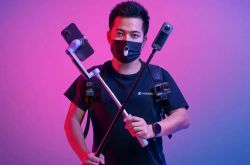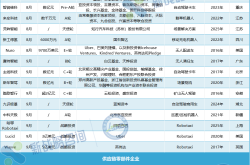Domestic Mobile Brands Gear Up to Compete with Apple
![]() 10/17 2025
10/17 2025
![]() 441
441
Concerns loom amidst a general downturn in mobile phone sales, coupled with the struggle to penetrate the premium market segment.
It's hardly breaking news that domestic mobile phone brands are setting their sights on Apple. OPPO positions itself as "a viable alternative for Apple enthusiasts," vivo aims to "win over Apple's loyal customer base," and Honor is determined to "dethrone Apple from its dominance in the high-end mobile phone arena."
However, Xiaomi's recent move to name its phones in a manner reminiscent of the iPhone sparked a significant backlash on social media. Despite Lei Jun's subsequent clarification regarding the renaming of the Xiaomi 17, the perceived over-reliance on rigid benchmarking has done little to alter the widespread stereotype about Xiaomi.
Behind these strategies lies a palpable anxiety over declining mobile phone sales and the uphill battle to enter the high-end market. While external criticism of imitation and copying abounds, learning from and benchmarking against the iPhone have actually yielded tangible benefits for domestic mobile phone brands. Yet, many still question whether such benchmarking and imitation can truly pave the way for achieving a high-end market position.
01 Prioritizing Form or Function?
While the iPhone faces criticism for its perceived lack of innovation, domestic mobile phone brands are actively drawing inspiration from Apple's product strategies.
In previous years, OPPO made several strategic shifts in an attempt to break into the high-end market, once aspiring to emulate Huawei's success by hiring Jiang Wen as a spokesperson and adopting a vegan leather finish. Realizing the lack of positive reception, OPPO eventually refocused on appealing to younger consumers, with Sun Yingsha as its latest spokesperson.
Behind this market strategy pivot, OPPO has consciously started to emulate the iPhone in recent years, earning itself the moniker "Ophone" among the public. It not only seeks compatibility with Apple's software ecosystems but also leans towards iPhone-inspired product designs. As a leading mobile phone manufacturer consistently ranking among the top three domestically, OPPO has faced internal opposition to this approach, with concerns that aligning too closely with the iPhone could tarnish its own brand image.
However, the reality is that the product most resembling the iPhone has been the top seller. The OPPO Find X8 standard version, dubbed the "Ophone," accounted for over half of the sales across the entire product line.
A similar trend has emerged with vivo. In recent years, vivo has adopted the slogan "Apple alternative," with product designs and feels reminiscent of the iPhone. The most notable example is the compact straight-screen vivo X200S, which features a size and right-angled edge design akin to the iPhone, making it appear very similar from the front and side. This phone has also become the best-selling model in the vivo X200 series.
Among these brands, Xiaomi stands out as the most experienced and has reaped significant benefits. According to its latest disclosed data, the Xiaomi 17 series sold 1 million units in just three days. In fact, the last time Xiaomi skipped a number in its series was in 2018 when the Xiaomi 7 was not released, and it directly jumped to the Xiaomi 8. The Xiaomi 8 also became the first to imitate the notch screen design introduced by the iPhone X at the time. The Xiaomi 8 sold over 6 million units in six months, becoming one of the best-selling models in the Xiaomi series.
Faced with concrete sales data, the mobile phone industry's narrative over the past decade seems to repeatedly validate one point: rather than feeling our way across the river, it's better to ride the iPhone across. Between form and function, the pressure of performance and market rankings always forces manufacturers to choose the latter.
In fact, in the eyes of many, domestic manufacturers benchmarking against the iPhone is not simply a matter of imitation and copying. Unlike the direct copying of the iPhone by a host of counterfeit mobile phone manufacturers like NiCai in the past, current mobile phone manufacturers have already acquired significant strength, with notable progress in both technology and product experience.
Duan Yongping once expressed a viewpoint on a TV program years ago: most consumers do not truly value whether a product is original or possesses any core technology. Originality is often overly mythologized, and "no successful innovation starts without imitation."
As a consumer electronic product, mobile phone design should prioritize functionality, and excessive showmanship is inappropriate. Smartphones, as a highly mature category, have long been simplified, with no one designing phones with unnecessary flip covers or adding a plethora of physical buttons. Except for the foldable form factor in recent years, the optimal design for straight-screen phones is essentially what we see now, with differences only in camera shape (round or square), R-angle size, and bezel width.
When innovation slows down, learning from the industry leader may not be the most correct choice, but it is at least not the wrong one.
02 The 'Curse' of High-End Market Positioning
The mobile phone business is quite peculiar. Apple and Xiaomi represent two extremes: Apple takes 80% of the industry's profits, while Lei Jun's marketing efforts over the years have resulted in Xiaomi's profits being pitifully low, with cost-effectiveness becoming a long-standing issue.
2019 marked a turning point for domestic mobile phones to collectively aim for the high-end market. A major variable at the time was Huawei, which, occupying nearly 40% of the domestic mobile phone market share, was sanctioned by the United States and lost support for the most advanced chips, leading to a severe decline in Huawei mobile phone sales. Although no one explicitly said so, deep down, there was a hope to inherit Huawei's high-end user base.
However, the biggest variable came from the overall decline in the mobile phone market. Domestic smartphone shipments peaked around 2017 and then entered a prolonged period of sales decline, with shipments in 2024 reaching less than 300 million units.
When the growth dividend disappeared, there were only two paths ahead: either explore new markets or improve existing operations.
The reality is that most mobile phone manufacturers have pursued both paths. Besides entering the tablet and smartwatch markets, Xiaomi and Huawei have ventured into the automotive sector, vivo has bet on embodied intelligence and robotics, while OPPO and Honor's strategies are not yet clear, but recently, there have been rumors that OPPO plans to enter the action camera market.
In terms of existing operations in the mobile phone market, opportunities for growth through product innovation alone are becoming increasingly scarce.
Foldable screens have been a collective focus for manufacturers in recent years, and their innovative form factor once excited the market. However, the penetration rate of foldable screens is not high enough to significantly impact overall market performance. In the first half of 2025, nearly 5 million foldable screen phones were shipped in China, accounting for only 3.5% of total market sales. Moreover, Huawei alone accounted for 75% of the market share in foldable screen shipments.
AI is another concept that the industry has placed high hopes on in recent years. However, the reality is that AI is far from being able to significantly influence user decisions on a large scale. A survey conducted by the U.S. tech media outlet CNET found that only 11% of U.S. users would choose to upgrade their devices because of AI features. Last year, this proportion was 18%.
In the domestic market, multiple mobile phone industry insiders have also admitted to Shuzhi Qianxian that AI phones are currently more in the conceptual stage, with very limited impact on sales. Since domestic mobile phone manufacturers hyped up the concept of AI phones in early 2024, they have also actively cooled down the hype and returned to focusing on features like imaging and battery life that can directly impact sales.
When there is a lack of fresh developments in the mobile phone market, the market evolves into a zero-sum game. Nearly all domestic mobile phone manufacturers have simultaneously embarked on a journey towards high-end market positioning, hoping to achieve higher brand premiums by raising product positioning and prices. And their path to high-end market positioning all aims at the same target—taking a share of Apple's market.
Hu Baishan, Executive Vice President and COO of vivo, mentioned earlier this year that in the mobile phone markets priced above 4,000 yuan and 6,000 yuan, Apple occupies approximately 60% and 80% of the market shares, respectively. For domestic brands to achieve breakthroughs in the markets priced above 4,000 yuan and 6,000 yuan, the largest source of users will be Apple.
An interesting change is that in recent years, compared to the Net Promoter Score, more manufacturers are concerned about another metric—the iPhone conversion rate.
Data from QuestMobile shows that in 2019, the proportion of iPhone users switching to Xiaomi was only 3.2%, which increased to 6.1% by 2025. After the release of the Xiaomi 15, Lu Weibing revealed that approximately 20% of users came from iPhone. OPPO has also specifically mentioned that among the online debut users of the OPPO Find N5, over 40% were conversions from iPhone users.
iPhone users have become a rich source for domestic mobile phone brands' transformation towards high-end market positioning, and how to attract these users has become an industry effort.
As is well known, the iPhone's continued leadership in the high-end market is attributed to its top-notch hardware design and system experience, especially the iOS system, which has become the key to retaining the iPhone's core user base. The closed system experience has allowed the iPhone to achieve smoother performance than Android manufacturers with smaller memory and lower pixel counts for a long time.
In recent years, besides benchmarking against the iPhone in terms of products and marketing strategies, OPPO, Xiaomi, vivo, and Honor have also taken a noticeable action of actively seeking compatibility with the Apple ecosystem. Through file transfer software, they enable file, image, and video transfers with Apple devices. At the same time, these manufacturers also support opening documents in Apple's special formats, attempting to create a breach in Apple's most fortified ecological stronghold.
03 Can Imitation and Benchmarking Lead to True High-End Market Positioning?
It cannot be denied that the industry's practice of benchmarking against Apple has shown effectiveness on the path to high-end market positioning.
The market segment priced between 4,000 and 6,000 yuan has become a breakthrough point for domestic mobile phone brands in the high-end market. In the first half of 2025, the top five domestic market players in this price segment were Huawei, Xiaomi, vivo, Apple, and OPPO, with the iPhone's share rapidly shrinking.
This effect is not only reflected in sales volume; the product capabilities of domestic mobile phones have also been visibly improving in recent years. For example, although the industry still believes that the iPhone leads in video recording capabilities, domestic manufacturers have gained increasing recognition from users in terms of algorithm tuning and the application of large-size sensors in photography. Moreover, although the iPhone still maintains sufficient attractiveness in system optimization, many new technologies are first applied on Android phones.
However, the practice of brands like Xiaomi frequently benchmarking against Apple in product launches has also sparked resentment and doubt from many. A highly representative comment is: Xiaomi has chosen the most inferior strategy at a time when it should be the most confident. What the outside world sees is not Xiaomi's courage to challenge the world's number one, but rather its eagerness for attention and topics.
Statistics show that during the Xiaomi 14Ultra launch event in 2024, the iPhone was mentioned 23 times; while during the Xiaomi 17 series launch event, Lei Jun mentioned the iPhone and Apple 37 times.
Not only Xiaomi, but vivo, OPPO, and Honor also mention and compare themselves to the iPhone in almost every launch event. In contrast, the iPhone never mentions its competitors during its launch events. This discrepancy raises a core question: can domestic mobile phone brands achieve true high-end market positioning through benchmarking or imitation?
Xiaomi first proclaimed "comprehensive benchmarking against Apple" at the Xiaomi 12 launch event at the end of 2021, with Lei Jun stating: If Xiaomi does not have the courage and determination to benchmark against the iPhone, how can it make good high-end mobile phones?
However, in the eyes of the outside world, Xiaomi should not be so concerned with formal benchmarking. Using internal motivational slogans as a means of influencing user decisions appears very deliberate. During every launch event, Lei Jun's speeches are filled with displays of sincerity and emotional appeal, but this carefully orchestrated narrative has started to immunize more and more people.
In an interview after the Xiaomi 17 launch event, Lei Jun expressed surprise at the public sentiment, stating that the intention behind renaming Xiaomi was to encourage everyone to re-evaluate Xiaomi mobile phones and change preconceived notions. However, Xiaomi's simple and crude approach essentially deepens stereotypes.
The excitement and noise generated by imitation and benchmarking amplify distractions and divisions, leading to a growing sense of fragmentation in the brand. This fragmentation results in loyal fans becoming even more devoted, while the broader audience finds it difficult to derive sufficient recognition and emotional value. However, if it cannot gain recognition from the broader audience, high-end market positioning will inevitably remain a celebration within a small circle.
Moreover, when "benchmarking against Apple" becomes the core strategy, it is easy to fall into a passive position. In recent years, the iPhone has frequently used price reductions and other means to squeeze the space of domestic mobile phone brands. If domestic brands cannot provide sufficient irreplaceability, they will ultimately find themselves in a passive and defensive position.
This challenge is not exclusive to Xiaomi; it also poses a significant hurdle for other domestic mobile phone brands. While benchmarking or even imitating the iPhone may drive sales growth in their high-end product lines, achieving a truly high-end brand market positioning still demands a prolonged period of consistent effort and accumulation.
In the art of kendo, there exists a philosophical framework known as 'Shu-Ha-Ri': 'Shu' represents the mastery of techniques passed down by predecessors; 'Ha' signifies the breaking of traditions to refine and enhance existing techniques; and 'Ri' embodies the creation of one's own unique theories. When we set aside the marketing hype in the mobile phone industry, it becomes evident that domestic manufacturers have indeed made remarkable strides in areas such as imaging capabilities, battery longevity, heat dissipation, and overall system experience. Nevertheless, the majority of these brands still find themselves in the 'Ha' phase, having not yet developed a genuine, systematic approach to securing a foothold in the high-end market.






